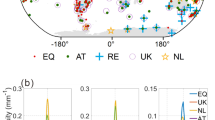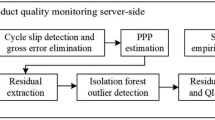Abstract
This paper focuses on PPP-B2b, one of the featured services for BDS-3, which provides users around China with centimetre-level static positioning accuracy and decimetre-level kinematic positioning accuracy by broadcasting precise corrections for GPS/BDS-3 satellites. The GEO PPP-B2b signal broadcasted information types, including the PRN mask, orbit corrections, differential code bias corrections and clock corrections, are introduced, as well as a brief description of their usage. A new orbit determination strategy using regional L-band code/phase measurements and inter-satellite link measurements in combination and a real-time clock estimation strategy based on the Kalman filter for PPP-B2b precise correction generation are introduced in this contribution. Then, the accuracy of the orbit and clock corrections is assessed. The orbit user ranging error (URE) is 0.05 m for the BDS-3 MEO and GPS satellites. The orbit URE for BDS-3 IGSO satellites is worse, i.e., 0.15 m. The clock correction accuracy is 0.2 ns for BDS-3 and GPS satellites. Finally, the PPP-B2b performance is validated by both the static PPP process and simulated kinematic PPP process. BDS-3/GPS dual-system PPP offers faster convergence and better accuracy. The positioning accuracy achievable using PPP-B2b real-time products is at the same level as that using post-processed products. The RMS for BDS-3/GPS dual-system static positioning errors is less than 1.0 cm in east and north and about 3.0 cm in the up. The simulated kinematic positioning accuracy is better than 2.5 cm in the north, 3.5 cm in the east and 8.5 cm in the up directions after convergence.
Highlights
-
A new determination strategy using regional L-band code/phase measurements and inter-satellite link measurements in combination and a real-time clock estimation strategy based on the Kalman filter for PPP-B2b precise correction generation are introduced.
-
User ranging error (URE) is 0.05 m for the BDS-3 MEO and GPS satellites.
-
The clock correction accuracy is 0.2 ns for BDS-3 and GPS satellites.
-
The positioning accuracy achievable using PPP-B2b real-time products is at the same level as that using post-processed products.












Similar content being viewed by others
References
Boehm J, Niell A, Tregoning P, Schuh H (2006) Global mapping function (GMF): a new empirical mapping function based on numerical weather data. Geophys Res Lett 33:L07304. https://doi.org/10.1029/2005GL025546
Calais E, Han JY, DeMets C, Nocquet JM (2006) Deformation of the North American plate interior from a decade of continuous GPS measurements. J Geophys Res 111:B06402. https://doi.org/10.1029/2005JB004253
Chen JP, Hu XG, Tang CP, Zhou SS, Yang YF, Pan JY, Ren H, Ma YX, Tian QN, Wu B, Yu Y (2020) SIS accuracy and service performance of the BDS-3 basic system. Sci China Phys Mech Astron 63(6)
CSNO (2017) BeiDou navigation satellite system signal in space interface control document-B1C (Version 1.0). China Satellite Navigation Office, 2017
CSNO (2019a) China satellite navigation office, development of the BeiDou navigation satellite system 4.0, China Satellite Navigation Office, 2019a
CSNO (2019b) BeiDou navigation satellite system signal in space interface control document-precise point positioning service signal PPP-B2b, China Satellite Navigation Office, 2019b
CSNO (2019c) Definitions and descriptions of BDS/GNSS satellite parameters for high precision application, China Satellite Navigation Office, 2019c
Fu W, Huang G, Zhang Q et al (2019) Multi-GNSS real-time clock estimation using sequential least square adjustment with online quality control. J Geodesy 93(7):963–976. https://doi.org/10.1007/s00190-018-1218-z
GPS Directorate (2019) Navstar GPS space segment/navigation user segment interfaces. Interface specification IS-GPS-200, revision K, 5 June 2019, Global Positioning Systems Directorate
Jiao W (2014) International GNSS monitoring and assessment system (iGMAS) and latest progress. In: Presented at China satellite navigation conference (CSNC) 2014, Nanjing, 20 May 2014
Kazmierski K, Sośnica K, Hadas T (2018) Quality assessment of multi-GNSS orbits and clocks for real-time precise point positioning. GPS Solutions, 2018, 22(1). https://doi.org/10.1007/s10291-017-0678-6
Kouba J, Héroux P (2001) Precise point positioning using IGS orbit and clock products. GPS Solut 2001, 5(2):12–28. https://doi.org/10.1007/PL00012883
Kouba J (2004) Improved relativistic transformations in GPS. GPS Solut 8(3):170–180. https://doi.org/10.1007/s10291-004-0102-x
Kouba J (2009) A simplified yaw-attitude model for eclipsing GPS satellites. GPS Solut 13(1):1–12. https://doi.org/10.1007/s10291-008-0092-1
Liu C, Gao W, Liu T, Wang D, Yao Z, Gao Y, Nie X, Wang W, Li D, Zhang W, Wang D, Rao Y (2020) Design and implementation of a BDS precise point positioning service. Navigation 67(4):875–891. https://doi.org/10.1002/navi.392
Montenbruck O, Steigenberger P, Khachikyan R, Weber G, Langley R, Mervart L, Hugentobler U, Langley K (2013) IGS-MGEX: preparing the ground for multi-constellation GNSS science. In: 4th international colloquium on scientific and fundamental aspects of the Galileo system, 4–6 December 2013, Prague, CZ
Montenbruck O, Schmid R, Mercier F, Steigenberger P, Noll C, Fatkulin R, Kogure S, Ganeshan A (2015) GNSS satellite geometry and attitude models. Adv Space Res 56(6):1015–1029. https://doi.org/10.1016/j.asr.2015.06.019
Montenbruck O, Steigenberger P, Prange L, Deng Z, Zhao Q, Perosanz F, Romero I, Noll C, Sturze A, Weber G, Schmid R, Macleod K, Schaer S (2017) The multi-GNSS experiment (MGEX) of the international GNSS service (IGS)—achievements, prospects and challenges. Adv Space Res 59(2017)7:1671–1697. https://doi.org/10.1016/j.asr.2017.01.011.
Petit G, Luzum B: IERS Conventions (2010) IERS technical note No. 36, Verlag des Bundesamts für Kartographie und Geodäsie, Frankfurt 2010
Rebischung P, Schmid R (2016) IGS14/igs14.atx: a new framework for the IGS products, AGU Fall Meeting, San Francisco, 2016, USA
Rocken C, Johnson J, Van Hove T, Iwabuchi T (2005) Atmospheric water vapor and geoid measurements in the open ocean with GPS. Geophys Res Lett 32:L12813. https://doi.org/10.1029/2005GL022573
Saastamoinen J (1972) Contributions to the theory of atmospheric refraction. B Géodes 105(1):279–298
Springer TA, Beutler G, Rothacher M (1999) A new solar radiation pressure model for GPS satellites. GPS Solut 1999, 2(3):50–62. https://doi.org/10.1007/PL00012757
Steigenberger P, Montenbruck O (2020) (2020) Consistency of MGEX orbit and clock products. Engineering 6:898–903. https://doi.org/10.1016/j.eng.2019.12.005
Tang CP, Hu XG, Zhou SS et al (2016) Improvement of orbit determination accuracy for BeiDou navigation satellite system with two-way satellite time frequency transfer. Adv Space Res 58(7):1390–1400. https://doi.org/10.1016/j.asr.2016.06.007
Tang C, Hu X, Zhou S, et al (2018) Initial results of centralized autonomous orbit determination of the new-generation BDS satellites with inter-satellite link measurements. J Geodesy 2018, 92(10):1–15. https://doi.org/10.1007/s00190-018-1113-7
Wang L, Li ZS, Ge MR, Neitzel F, Wang Z, Yuan H (2018) Validation and assessment of multi-GNSS real-time precise point positioning in simulated kinematic mode using igs real-time service. Remote Sens 2018, 10(2):337. https://doi.org/10.3390/rs10020337
Wang N, Yuan Y, Li Z et al (2016) Determination of differential code biases with multi-GNSS observations. J Geod 90(3):209–228. https://doi.org/10.1007/s00190-015-0867-4
Weiss JP, Steigenberger P, Springer T (2017) Orbit and clock product generation. In: Teunissen PJ, Montenbruck O (eds) Springer handbook of global navigation satellite systems. Springer handbooks. Springer, Cham. https://doi.org/10.1007/978-3-319-42928-1_34
Yang Y, Gao W, Guo S, et al (2019a) Introduction to Bei-Dou-3 navigation satellite system. Navigation 66(1):7–18. https://doi.org/10.1002/navi.291
Yang Y, Yang Y, Hu X et al (2019b) Inter-satellite link enhanced orbit determination for BeiDou-3. J Navig 2019:1–16. https://doi.org/10.1017/S0373463319000523
Yao Y, He Y, Yi W, Song W, Cao C, Chen M (2017) Method for evaluating real-time GNSS satellite clock ofset products. GPS Solut 21:1417–1425. https://doi.org/10.1007/s10291-017-0619-4
Zhang L, Yang H, Gao Y, et al. (2018). Evaluation and analysis of real-time precise orbits and clocks products from different IGS analysis centers. Advances in Space Research, 2018, 61(12): 2942–2954. https://doi.org/10.1016/j.asr.2018.03.029
Zhang S, Du S, Li W, et al (2019) Evaluation of the GPS precise orbit and clock corrections from MADOCA real-time products. Sensors 2019, 19(11):2580:1–13. https://doi.org/10.3390/s19112580
Zhang XH, Andersen OB (2006) Surface ice flow velocity and tide retrieval of the amery ice shelf using precise point positioning. J Geod 80(4):171–176. https://doi.org/10.1007/s00190-006-0062-8
Zhou SS, Cao YL, Zhou JH et al (2012) Positioning accuracy assessment for the 4GEO/5IGSO/2MEO constellation of COMPASS. Sci China Phys Mech Astron 55:2290–2299
Zhou SS, Hu XG, Zhou JH et al (2013) Accuracy analyses of precise orbit determination and timing for COMPASS/Beidou-2 4GEO/5IGSO/4MEO constellation. Lecture Notes Electr Eng 245:89–102
Zhou SS, Hu XG, Wu B et al (2011) Orbit determination and time synchronization for a GEO/IGSO satellite navigation constellation with regional tracking network. Sci China Phys Mech Astron 54:1089–1097
Zhu S, Reigber CH, König R (2004) Integrated adjustment of CHAMP GRACE and GPS data. J Geod 78(1–2):103–108. https://doi.org/10.1007/s00190-004-0379-0
Zumberge JF, Heflin MB, Jefferson DC, Watkins MM, Webb FH (1997) Precise point positioning for the efficient and robust analysis of GPS data from large networks. J Geophys Res Solid Earth 1997(102):5005–5017. https://doi.org/10.1029/96JB03860
Acknowledgements
This research is funded by National Key Research and Development Program of China (2016YFB0501405) and National Natural Science Foundation of China (Grant No. 41804030, 41874039, 41874043, 41574029 and 41674041).
Author information
Authors and Affiliations
Contributions
XH and JC provided the initial idea for this study. CT and XH wrote the article. CT and LL developed the real-time clock estimation software and conducted the experiments. SZ and RG conducted the inter-satellite link enhanced orbit determination experiments. XL and Feng He analysed the information type of PPP-B2b message. Jianhua Yang evaluated orbit and clock accuracy. JL conducted the precise point positioning experiments.
Corresponding author
Ethics declarations
Conflict of interest
The authors declare that they have no conflict of interest.
Data availability
The PPP-B2b broadcast message can be obtained with a customized receiver following the public PPP-B2b ICD of BDS-3. Measurements of iGMAS stations for evaluation can be obtained via application. The GFZ products can be download from the IGS website.
Rights and permissions
Springer Nature or its licensor holds exclusive rights to this article under a publishing agreement with the author(s) or other rightsholder(s); author self-archiving of the accepted manuscript version of this article is solely governed by the terms of such publishing agreement and applicable law.
About this article
Cite this article
Tang, C., Hu, X., Chen, J. et al. Orbit determination, clock estimation and performance evaluation of BDS-3 PPP-B2b service. J Geod 96, 60 (2022). https://doi.org/10.1007/s00190-022-01642-9
Received:
Accepted:
Published:
DOI: https://doi.org/10.1007/s00190-022-01642-9




